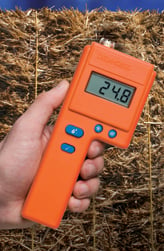For farmers, moisture is a constant concern. The moisture level of the soil and the humidity in the air can have a major impact on any crop harvest. When it comes to harvesting hay, moisture needs to be strictly monitored and controlled in order to ensure that the hay being produced is as nutritive as possible.
Thanks to modern technology such as hay moisture probes, farmers can now know the moisture content of their hay more accurately than ever before. However, with the variety of hay moisture probes available to choose from, it can be difficult to choose the right one for your needs.
In particular, it can be difficult to choose between baler-mounted moisture meters and portable models. To help you make the right choice for your needs, we’ve assembled a short list of the pros and cons of these two types of hay moisture meters so you can have a more informed opinion of which is best for you.
Pros of Baler-Mounted Moisture Meters
What could possibly be more convenient than knowing the moisture content of hay as it’s getting baled? Baler-mounted moisture meters have several advantages, such as:
- The ability to draw power from your tractor. In the vast majority of cases, a baler-mounted unit has a power adaptor to allow it to get electricity from the tractor itself, meaning it won’t run out of power as long as your tractor’s working.
- Real time information as you harvest. When using a baler-mounted moisture meter, you are getting up-to-the-second information about the moisture content of the hay being baled. As soon as the hay you’re baling falls out of the optimal moisture level for harvesting, you’ll know.
The ability to get instant feedback about the moisture content of your hay bales is what makes baler-mounted meters such a great tool for harvesting hay. With that information, you are able to avoid accidentally continuing to bale hay that is too dry and losing the leafy portions of herbaceous hay plants that are so vital to the nutritive value of that hay.
Cons of Baler-Mounted Moisture Meters
“What are the disadvantages of meters that are attached to the baler,” you ask?
Well, to begin, the biggest disadvantage to using a baler-mounted meter is that you have to already be harvesting hay before it can start taking moisture measurements. If the hay’s moisture content was not in the right range to begin with, you won’t know until you’ve already started making bales.
With a baler-mounted unit, you cannot take measurements in a windrow before the baling process begins to make sure that it is ready in the first place.
Also, with a baler-only unit, you cannot check the moisture content of hay bales when getting ready to store them. Ideally, hay’s moisture content should be checked before, during and after baling.
Pros of Portable Moisture Meters
With a portable moisture meter, you’re able to take readings of the hay before the harvesting process begins as well as after it’s baled. By taking measurement of the hay before baling, you can avoid harvesting hay that isn’t ready, avoiding many moisture-related problems before they begin.
Also, with a portable moisture probe, you can take readings in finished bales to double-check them before storage in case it begins to rain while you’re busy baling. A last minute drizzle could either be nothing to worry about, or it could cause stored hay to explode. Water absorbs heat, and when stored in a closed environment, such as a silo, wet hay can undergo a chemical reaction that causes explosions. Knowing if the hay is within acceptable moisture levels right before storage can be a literal life-saver.
Portable moisture meters often have the ability to swap out probe types, allowing them to be useful for many different types of hay bales. For example many of Delmhorst’s moisture meters for hay support both 10” and 18” length probes for reaching the center of larger hay piles and bales.
Beyond that, portable meters are light, easy-to-use and adaptable.
Cons of Portable Meters
 Unlike baler-mounted units, portable moisture meters cannot give you a real-time measurement of your hay’s moisture content as you’re baling it. This means that while you’re baling, if the moisture content of the hay changes significantly (which will happen as the day goes on), you won’t know it unless you stop to recheck the windrow and the bales you’ve just made periodically.
Unlike baler-mounted units, portable moisture meters cannot give you a real-time measurement of your hay’s moisture content as you’re baling it. This means that while you’re baling, if the moisture content of the hay changes significantly (which will happen as the day goes on), you won’t know it unless you stop to recheck the windrow and the bales you’ve just made periodically.
Having to stop to take measurements repeatedly slows down the collection process, which can mean a smaller yield for that day than what would be possible with a baler-mounted unit.
Also, portable units have to use their own power supply (typically a 9-volt battery), meaning that they can run out of power during standard use. Better-made portable moisture meters will usually have a battery status warning to let you know if you’re running low, however.
Meters are Not Mutually Exclusive
Of course, if you want to enjoy all of the benefits of portable and baler-mounted moisture meters, you can get both. By using both types of meters, you’ll have the most complete picture of your hay’s moisture content from start to finish.
In fact, Delmhorst’s own FX-2000 meter sports both baler-mounted and portable modes, giving you the best of both worlds in a single device. Read moisture in the field in the portable mode, then attach it to the baler mount for your tractor and get up-to-date readings while on the go!

Comments